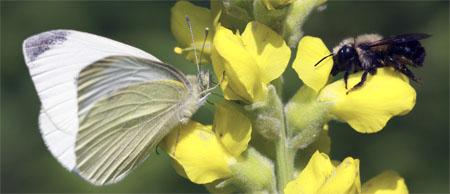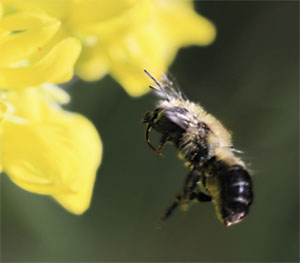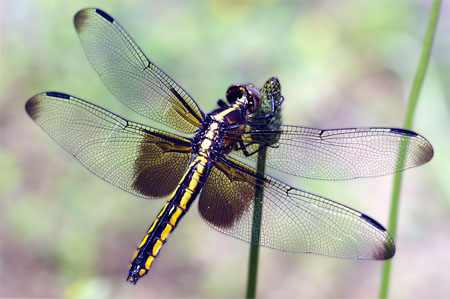Giant Insect Photos

I”m catching on ![]() I finally got my head wrapped around what I need to do to take good macro photos. As I’ve mentioned before, because macro photography generally involves getting the camera lens right up close to a really small subject, there isn’t much available light to reflect back into the camera. This results in the aperture of the lens opening up really far, and likely a slow shutter speed as well . . . so your depth of field becomes ridiculously shallow (a few millimeters), and a tiny little bit of camera shake can kill your photo.
I finally got my head wrapped around what I need to do to take good macro photos. As I’ve mentioned before, because macro photography generally involves getting the camera lens right up close to a really small subject, there isn’t much available light to reflect back into the camera. This results in the aperture of the lens opening up really far, and likely a slow shutter speed as well . . . so your depth of field becomes ridiculously shallow (a few millimeters), and a tiny little bit of camera shake can kill your photo.
 Focusing becomes critical – this is no time to rely on your camera’s autofocus. My Canon 40D generally has a great autofocus, and the ultrasonic motor in my 100mm macro lens is smooth and fast . . . but it’s still no match for a flying bumblebee. The key is to focus fast and then snap a couple shots as you incrementally adjust the focus ring. With a focal plane of a couple millimeters, it’s nearly impossible to tell through the viewfinder whether you are focused on the bee”s head or just a stray hair on its back that is pointed towards the camera. And the autofocus obviously has the same problem. In addition to the fact that when you try to focus on an object that is moving in and out of the focal plane, the autofocus will never manage to get a good lock – it will scan the macro focus range, not find anything, then focus way out in standard mode at which point it probably picks up a tree or something in the background. There goes your beautiful bumblebee photo, because by the time you get your bearings and crank the focus ring back down to macro range it’s gone.
Focusing becomes critical – this is no time to rely on your camera’s autofocus. My Canon 40D generally has a great autofocus, and the ultrasonic motor in my 100mm macro lens is smooth and fast . . . but it’s still no match for a flying bumblebee. The key is to focus fast and then snap a couple shots as you incrementally adjust the focus ring. With a focal plane of a couple millimeters, it’s nearly impossible to tell through the viewfinder whether you are focused on the bee”s head or just a stray hair on its back that is pointed towards the camera. And the autofocus obviously has the same problem. In addition to the fact that when you try to focus on an object that is moving in and out of the focal plane, the autofocus will never manage to get a good lock – it will scan the macro focus range, not find anything, then focus way out in standard mode at which point it probably picks up a tree or something in the background. There goes your beautiful bumblebee photo, because by the time you get your bearings and crank the focus ring back down to macro range it’s gone.
I”ve saved the best for last though . . . I had been frustrated with my inability to create depth in my photos with my macro lens since everything that needs to be in focus has to be in the same plane. Turns out you can trick the eye substantially by rotating the camera. Keep the plane of the lens perpendicular to the subject, but just rotate the camera so that your object spans diagonally across the image. It means thinking a little differently about composition, but it works.

Your other option for creating depth of course is artificial lighting (so that you can use smaller apertures and increase your focal depth). Your flash is not likely to help because the barrel of the lens will cast a shadow on the subject at close proximity. That’s why camera companies make ringlights which mount to the end of the lens. Unfortunately, ringlights are expensive and have a serious drawback – they create perfectly flat lighting. Oh, and they are heavy and bulky, though they do have the advantage of interfacing perfectly with your hotshoe. Anyway. The solution here is to mount a couple LEDs on flexible “antennae” that you can switch on and off. Attach them to your camera, and you should have a perfectly flexible miniature studio for dynamic lighting of small things ![]() This is my next project, I’ll keep you updated on how it goes.
This is my next project, I’ll keep you updated on how it goes.
By the way, the above photos were taken at the Cincinnati Nature Center – a privately owned and amazingly well kept nature preserve that is open to the public. It’s beautiful and secluded, tucked away in Milford . . . I highly recommend it ![]()
And yes, I know that I’m getting double apostrophes in my posts and that some of my old images have disappeared . . . working on that – I switched servers recently (upgraded to a dedicated system! ![]() ) and it’s screwing with my WordPress installation. Anyway, hopefully just a temporary issue!
) and it’s screwing with my WordPress installation. Anyway, hopefully just a temporary issue!



Leave a Reply